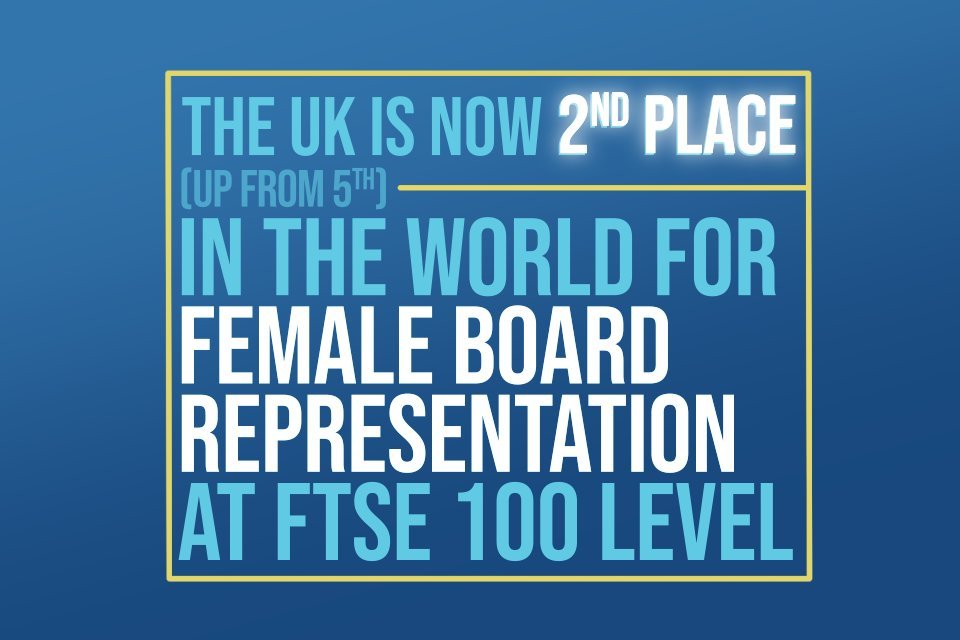Women make up nearly 40% of FTSE 100 top table roles

The UK has climbed to second in the international rankings for women’s representation on boards at FTSE 100 level, with new data to be released today (22 February 2022) showing nearly 40% of UK FTSE 100 board positions are now held by women, compared with 12.5% just 10 years ago.
The data has been published in a new report by the government-backed FTSE Women Leaders Review, which monitors women’s representation in 24,000 positions on FTSE 350 Boards and in leadership teams of the UK’s biggest companies, building on the success of the previous Hampton-Alexander and Davies Reviews.
Today’s findings demonstrate a major sea-change in attitudes to getting women leaders to the top table of business in the UK, with women’s board representation increasing in 2021 across the FTSE 100 (39.1%), FTSE 250 (36.8%) and FTSE 350 (37.6%).
The report highlights the success of the UK government’s voluntary, business-led approach to setting targets for getting more women on boards, as the UK progressed from fifth to second in the international rankings at FTSE 100 level, leapfrogging countries such as Norway, which enforces a mandatory quota system on businesses.
Business Secretary Kwasi Kwarteng said:
"UK businesses have made enormous progress in recent years to ensure that everyone, whatever their background, can succeed on merit - and today’s findings highlight this with more women at the top table of Britain’s biggest companies than ever before.
However, we should not rest on our laurels, and the FTSE Women Leaders Review will build on the success so far of our voluntary, business-led approach to increasing women’s representation on boards and in leadership, without the need for mandatory quotas."
The number of women in Chair roles across the FTSE 350 rose to 48, up from 39 in 2020, and there has been a significant decrease in the number of ‘One & Done’ boards to just 6 this year, as British businesses take action to diversify their boardrooms.
UK businesses have also continued to drive progress in their leadership teams in 2021, despite challenges faced in responding to COVID-19. There are over 700 more women in Leadership roles in the FTSE 350 companies this year, increasing women’s representation to 31.5%, an increase of 2% year-on-year.
While there has been remarkable progress at boardroom level, the report also shines a light on areas where there is still more to do. For example, only 1 in 3 leadership roles and around 25% of all executive committee roles are held by women and there are very few women in the CEO role. Equally, there are still many companies yet to hit the former 33% target set by the Hampton Alexander Review.
Minister for Women and Equalities, Liz Truss, said:
"It is excellent to see the progress being made, but we know there is more to be done.
This government is committed to levelling up all parts of our country, working to tackle inequality and promoting equality of opportunity, including at senior level, so everyone can thrive.
We will shortly put forward a range of measures to advance equality for women at work, increasing opportunity, and tackling the issues that are holding women back as we look to ensure that everyone can reach their full potential."
To ensure British companies continue to raise their game and open up opportunities to everyone, today’s FTSE Women Leaders Review report has set out bold new recommendations, including:
- the voluntary target for FTSE 350 Boards and for leadership teams is increased to a minimum of 40% women’s representation by the end of 2025
- FTSE 350 companies to have at least one woman in the Chair, Senior Independent Director role on the Board and/or one woman in the Chief Executive Officer or Finance Director role by the end of 2025
- extending the scope of the FTSE Women Leaders Review beyond FTSE 350 companies to include the largest 50 private companies in the UK by sales
These recommendations aim to increase gender balance further, bringing new focus to the appointment of women at the highest levels of British business, particularly in those companies that are still lagging behind.
Denise Wilson, Chief Executive, FTSE Women Leaders Review said:
"Today the FTSE Women Leaders Review announces 4 new recommendations for this next stage, which will embed the progress and hard-won gains of the last decade and take business further on the journey to gender balance in the boardroom and in leadership.
We know there is much more work to do and no shortage of experienced, capable women, ambitious for themselves and their company across all sectors of business today. So while we continue to build on progress for women on boards, we need to firmly shift focus in this next phase to women in leadership roles at the top of the organisation."
The government is also announcing today that KPMG and Lloyds Banking Group will be the corporate sponsors for FTSE Women Leaders Review in this next phase, providing important support to increase the number of women at the top of British business.
The government will appoint new Chairs to the FTSE Women Leaders Review shortly, to lead this next phase over its 4-year span.
See the February 2022 FTSE Women Leaders Review.
About the FTSE Women Leaders Review
The FTSE Women Leaders Review is an independent, business-led framework supported by the government, which sets recommendations for Britain’s largest companies to improve the representation of Women on FTSE 350 Boards and in FTSE 350 Leadership positions.
It tracks progress on 24,000 Board and leadership roles and builds on the excellent work of both the Hampton-Alexander and Davies Reviews over the last 10 years. The previous 33% target set in 2016, for Women on Boards was met in the aggregate for the FTSE 350 at the end of 2020, with the number of Women in Leadership just falling short of the target.
The new recommendations
1. There are 4 new recommendations announced today to fuel further progress in this next phase:
- the voluntary target for FTSE 350 Boards and for FTSE 350 Leadership teams is increased to a minimum of 40% women’s representation by the end of 2025
- FTSE 350 companies should have at least one women in the Chair, Senior Independent Director role on the Board and/or one woman in the Chief Executive Officer or Finance Director role by the end of 2025
- key stakeholders should continue to set best practice guidelines or use alternative mechanisms to encourage any FTSE 350 Board that has not yet achieved the previous 33% target for the end of 2020, to do so
- the scope of the Review is extended beyond FTSE 350 companies to include the largest 50 private companies in the UK by sales
Women on Boards – 2021 Progress
2. Reported numbers for Women on Boards of FTSE 350, as at 10 January 2022 (source: BoardEx), show:
FTSE 100 is at 39.1%, up from 36.2% in 2020
FTSE 250 is at 36.8%, up from 33.2% in 2020
FTSE 350 is at 37.6%, up from 34.3% in 2020
3. The number of women in the Chair role has increased to 48 across the FTSE 350, up from 39 in 2020.
FTSE 100 – 16 women Chairs
FTSE 250 – 32 women Chairs
4. The UK FTSE 100 is in 2nd place when compared internationally to 11 countries also working hard to improve the gender balance on the boards of public listed companies. This is up from 5th place in 2020 and the highest ranking since tracking began.
5. There are currently 4 companies in FTSE 350 with a women CEO and Chair duo, as at 10 January 2022:
Admiral Group Plc
Severn Trent Plc
Pennon Group Plc
Direct Line Insurance Group Plc
6. The number of FTSE 350 Boards that have met, or exceeded the previous 33% target has increased to 278 Boards, up from 220 in 2020.
7. The number of FTSE 350 Boards that have met, or exceeded the new 40% target is currently 140, 48 boards in the FTSE 100 and 92 in the FTSE 250.
Women in Leadership – 2021 Progress
8. Reported numbers for Women in Leadership (defined as the Executive Committee & Direct Reports to the Executive Committee on a combined basis), as at 31 October 2021 (source: FTSE Women Leaders data collection portal), show:
FTSE 100 is at 32.5% up from 30.6% in 2020
FTSE 250 is at 30.7% up from 28.5% in 2020
FTSE 350 is at 31.5% up from in 29.4% in 2020
9. Reported numbers for women on Executive Committees, as at 31 October 2021 (source: FTSE Women Leaders data collection portal), show:
a. FTSE 100 is at 25.9% down from 26.5% in 2020.
b. FTSE 250 is at 24.4% up from 21.7% in 2020.
c. FTSE 350 is at 25% up from 23.6% in 2020.
10. There are 18 CEOs across the FTSE 350 as at 10 January 2022, (source: BoardEx and other public and/or statutory sources), split by:
d. FTSE 100 has 8 women CEOs.
e. FTSE 250 has 10 women CEOs.
11. The number of all-male Executive Committees in the FTSE 350 has decreased again this year to 16, down from 28 in 2020. (Source: FTSE Women Leaders data collection portal)
12. There are 49 women Chief Financial Officers in the FTSE 350 as at 10 January 2022. (Source: BoardEx and other public and/or statutory sources)
International table
Over the years the FTSE Women Leaders Review (formerly the Hampton Alexander and Davies Reviews) has tracked its progress in increasing the representation of women on boards of public listed companies against other countries internationally. In 2021 the UK FTSE 100 ranks in second place compared against 11 similar counties, up from fifth place last year when compared with 12 similar countries.
International Women Leaders Index
| No. | Country | Index | % of board positions held by women 2021 |
|---|---|---|---|
| 1 | France | CAC | 43.80% |
| 2 | United Kingdom | FTSE 100 | 39.10% |
| 3 | Norway | OBX | 38.20% |
| 4 | Sweden | OMX Stockholm | 36.90% |
| 5 | Netherlands | AEX | 35.30% |
| 6 | Australia | S&P ASX | 35.10% |
| 7 | Finland | OMX Helsinki | 35.10% |
| 8 | Belgium | BEL Institutional | 34.30% |
| 9 | Spain | IBEX | 34.00% |
| 10 | Canada | S&P TSX | 33.70% |
| 11 | California | S&P | 32.30% |
| 12 | Germany | DAX | 30.50% |




